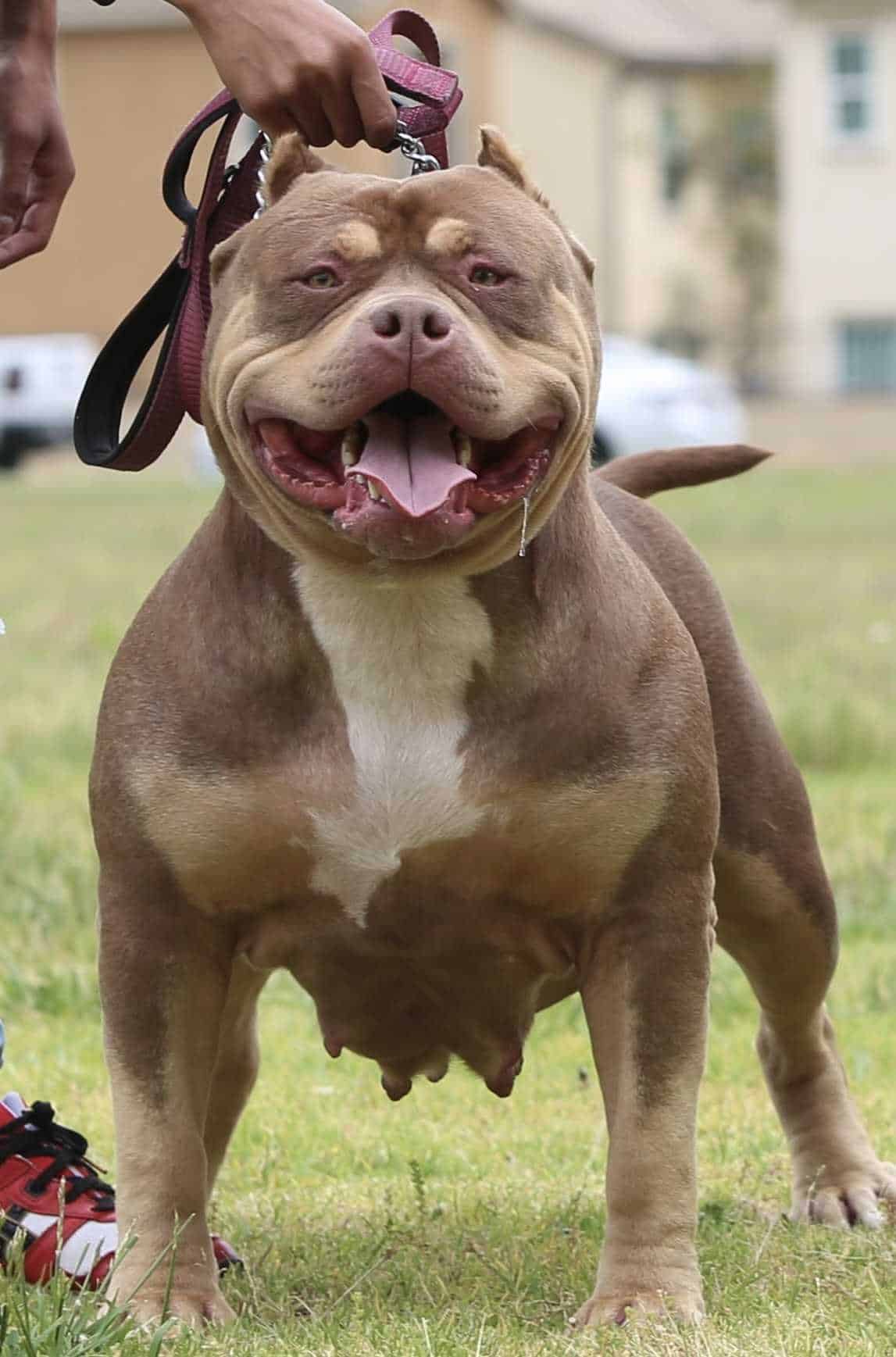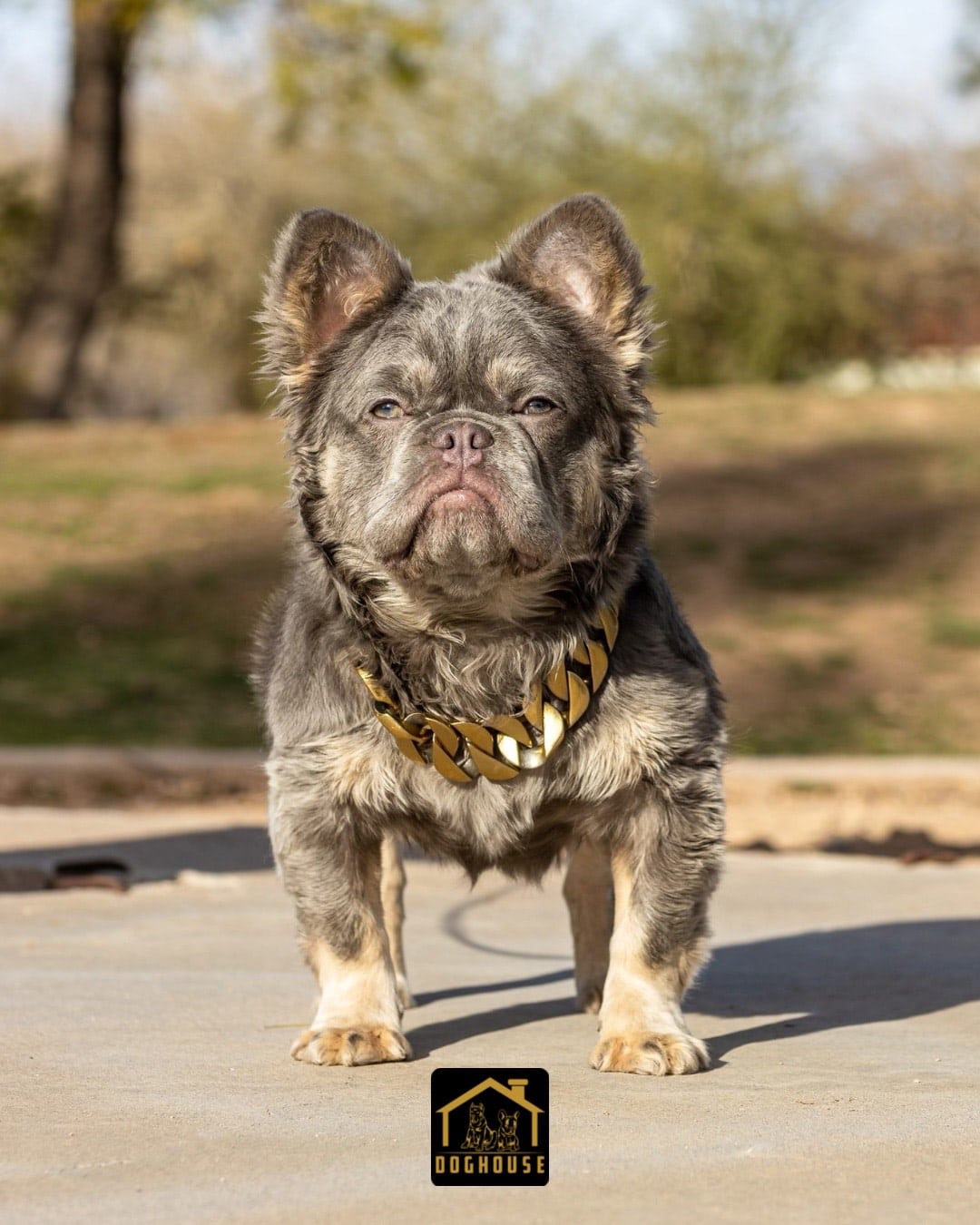The American Bully, a distinctive and robust breed, has carved a niche for itself in the canine world with its unique blend of strength, loyalty, and affability. Originating in the United States during the late 20th century, this breed is a testament to selective breeding aimed at achieving the perfect companion dog. Characterized by its muscular build, short coat, and a demeanor that oscillates between fierce loyalty to its family and a friendly disposition towards strangers, the American Bully stands as a symbol of power coupled with gentleness. Whether as a loyal protector or a loving family pet, the American Bully has proven that it is more than just its formidable appearance; it’s a breed with a heart of gold.
History of the American Bully
The American Bully, a distinct breed of companion dog, traces its roots back to the United States in the 1980s. Its inception was a result of crossbreeding the American Pit Bull Terrier, American Staffordshire Terrier, and a few other breeds. The primary objective behind this selective breeding was to produce a family companion dog that boasted a more muscular and bulkier physique than the American Pit Bull Terrier.
In terms of appearance, the American Bully is characterized by its short, stiff, and glossy coat, which can manifest in a myriad of colors and patterns, with the exception of merle. Despite its robust and formidable exterior, the breed is renowned for its affable and gentle nature. They are particularly cherished for their remarkable rapport with children and their ability to coexist harmoniously with other pets. Their unwavering loyalty to their families further accentuates their appeal as a household pet.
In the realm of dog breed classification, the United Kennel Club (UKC) and the American Bully Kennel Club (ABKC) acknowledges the American Bully. However, it’s worth noting that the American Kennel Club (AKC) does not extend the same recognition. The breed is diverse, with several varieties such as the Pocket, Standard, Classic, and XL. As with any breed, the American Bully is susceptible to specific health concerns. Hence, regular veterinary check-ups and a keen awareness of prevalent health issues can facilitate early detection and timely intervention. Beyond their laid-back demeanor, these dogs have a penchant for various activities and sports, including but not limited to obedience trials and agility competitions.
American Bully Temperament
The American Bully is known for its impressive, muscular build, but its temperament is often a pleasant surprise to those unfamiliar with the breed. Here’s an overview of the typical temperament of an American Bully:
1. Friendly and Sociable: Contrary to what their robust appearance might suggest, American Bullies are generally very friendly. They are known for their love of people and often greet friends and strangers alike with enthusiasm.
2. Loyal and Affectionate: These dogs are extremely loyal to their families. They form strong bonds with their owners and are known for being affectionate, often seeking out cuddles and attention.
3. Good with Children: American Bullies are typically very good with children. They are patient and can tolerate the playful, sometimes rough, behavior of kids. However, as with any breed, interactions between dogs and young children should always be supervised.
4. Intelligent and Trainable: They are intelligent dogs and respond well to training. Positive reinforcement techniques work best, as they are eager to please their owners. Their intelligence also means they can get bored easily, so mental stimulation is as important as physical exercise.
5. Confident and Stable: A well-bred American Bully should have a confident and stable temperament. They are not generally shy or overly aggressive. However, temperament can vary, and socialization from a young age is crucial to ensure they are well-adjusted.
6. Good with Other Pets: If raised with them or properly socialized, American Bullies can get along well with other pets. They can live harmoniously with other dogs and even cats.
7. Protective Instincts: While not aggressive, American Bullies do have protective instincts towards their families. They can be wary of strangers and may act as a deterrent, but they are not naturally aggressive.
8. Adaptable: They are relatively adaptable dogs. Whether living in a large house with a yard or an apartment, they can adjust as long as they get enough exercise and attention.
9. Energy Levels: They have a moderate energy level. They enjoy being active and need regular exercise, but they are also content to relax at home with their family.
10. Potential for Stubbornness: Like many breeds, they can sometimes be stubborn. Consistent training from an early age is important to establish rules and boundaries.
In summary, the American Bully is a breed that combines a strong and muscular physique with a gentle, affectionate, and loyal temperament. They make excellent family pets and companions, provided they are given the training, socialization, and attention they need.
How Much is an American Bully
The price of an American Bully can vary significantly based on its size, lineage, breeder reputation, location, and other factors. Here’s a general price range for American Bullies by size:
- Pocket Size: Ranging from $2,000 to $5,000 or more.
- Standard Size: Typically between $1,500 to $3,000.
- Classic Size: Prices can be around $1,500 to $2,500.
- XL Size: These larger Bullies can cost anywhere from $2,500 to $6,000 or even higher.
It’s essential to note that these are just average price ranges, and the actual cost can vary. High-quality dogs with proven track records for breeding or show can fetch much higher prices. Additionally, prices can fluctuate based on demand, the breeder’s reputation, geographic location, and the specific lineage of the dog.
Life Expectancy of an American Bully
The life expectancy of an American Bully typically ranges from 10 to 12 years. However, like all breeds, the lifespan can vary based on various factors including genetics, health, care, and living conditions.
It’s important to note that the American Bully’s lifespan can be influenced by factors such as:
- Diet: A balanced and nutritious diet can play a significant role in ensuring the health and longevity of the dog.
- Exercise: Regular exercise is crucial for maintaining the dog’s physical health and preventing obesity, which can lead to various health issues.
- Regular Vet Check-ups: Routine veterinary check-ups can help in early detection of potential health issues and ensure timely treatment.
- Genetics: Some lines or families of American Bullies might have specific health issues that can affect their lifespan.
- Living Conditions: A safe and comfortable living environment can contribute to the overall well-being of the dog.
It’s always recommended for owners to provide their American Bullies with proper care, regular check-ups, and a balanced diet to ensure a long and healthy life.
Size of the American Bully
The American Bully dog breed is known for its variety of sizes, each with distinct characteristics. Here are the different sizes of American Bullies:
- Pocket Bully: The Pocket American Bully is the smallest within the standard categories. Males measure under 17 inches, and females under 16 inches. Despite their smaller stature, they maintain the muscular build and robust appearance typical of the breed.
- Males under 17 inches (43 cm) and no shorter than 14 inches (36 cm) at the withers. Females under 16 inches (40cm) and no shorter than 13 inches (33 cm).
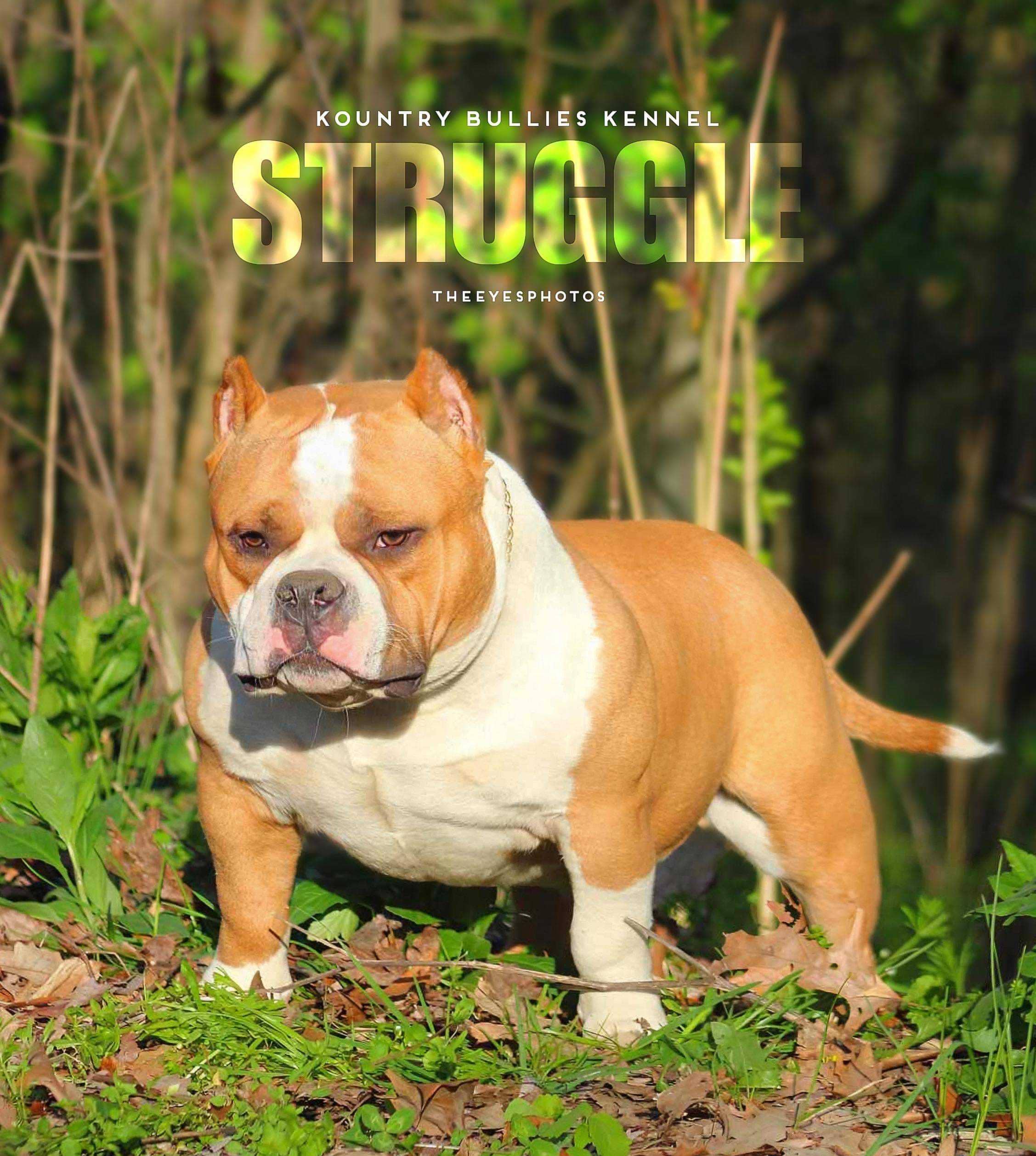
- Standard Bully: This is the standard size for the breed, with males measuring 17 to 20 inches and females 16 to 19 inches at the withers. The Standard Bully has a balanced build with a muscular and athletic physique.
- This is the most common size of the American Bully.
- It has a compact, muscular body structure.
- Males 17 inches – 20 inches (43 cm – 51 cm) at the withers. Females 16 inches – 19 inches (40 cm – 48 cm) at the withers.
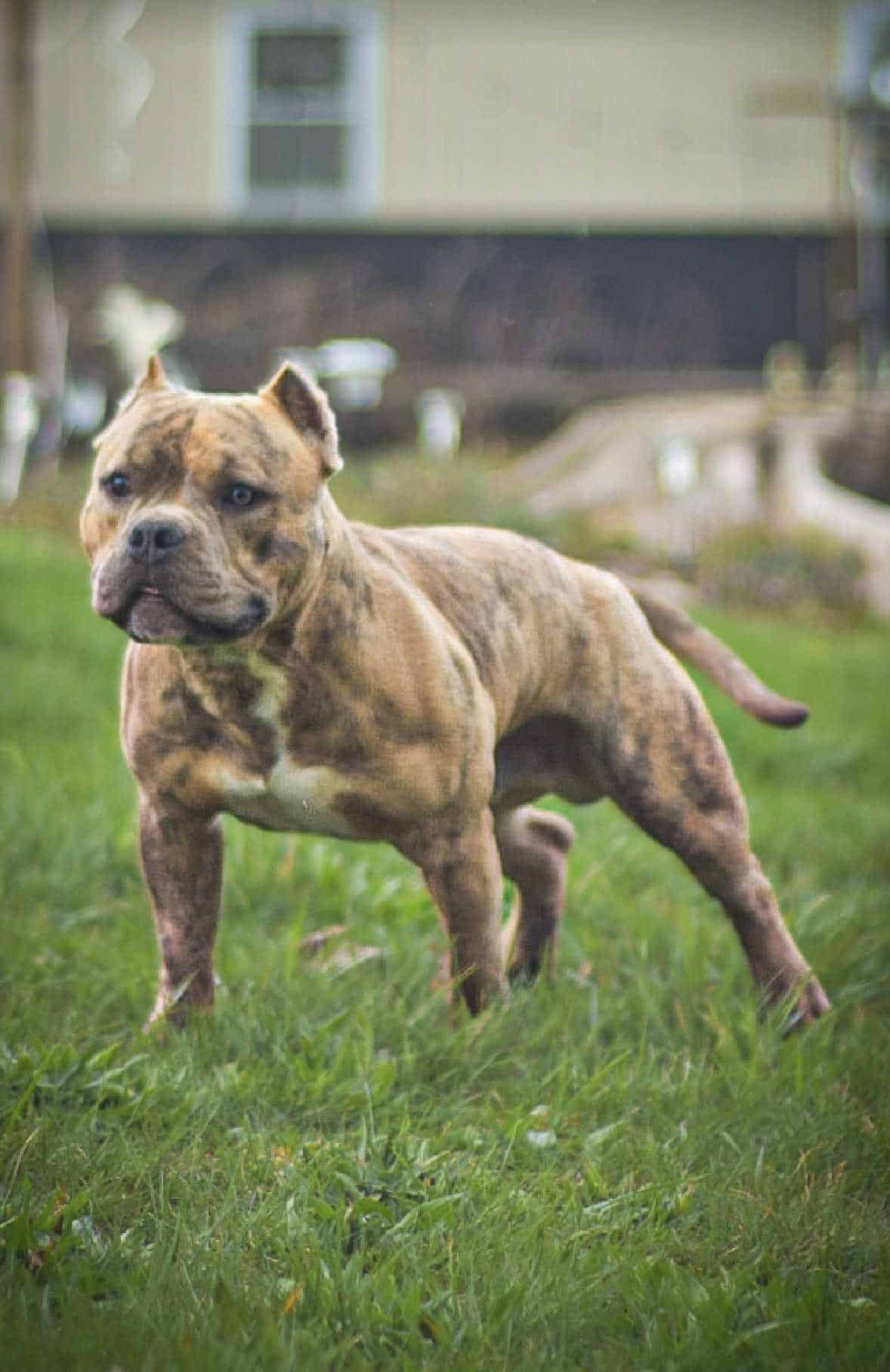
- XL (Extra Large) Bully: The XL American Bully is the largest size category. Males stand between 20 to 23 inches, while females measure 19 to 22 inches. These dogs are known for their substantial size and impressive musculature, maintaining the breed’s characteristic strength and agility.
- This size is taller and slightly more elongated than the standard.
- It’s known for its impressive size while still maintaining its agility.
- Males over 20 inches (51 cm) – 23 inches (57 cm) at the withers. Females over 19 inches (48 cm) – 22 inches (54 cm) at the withers.
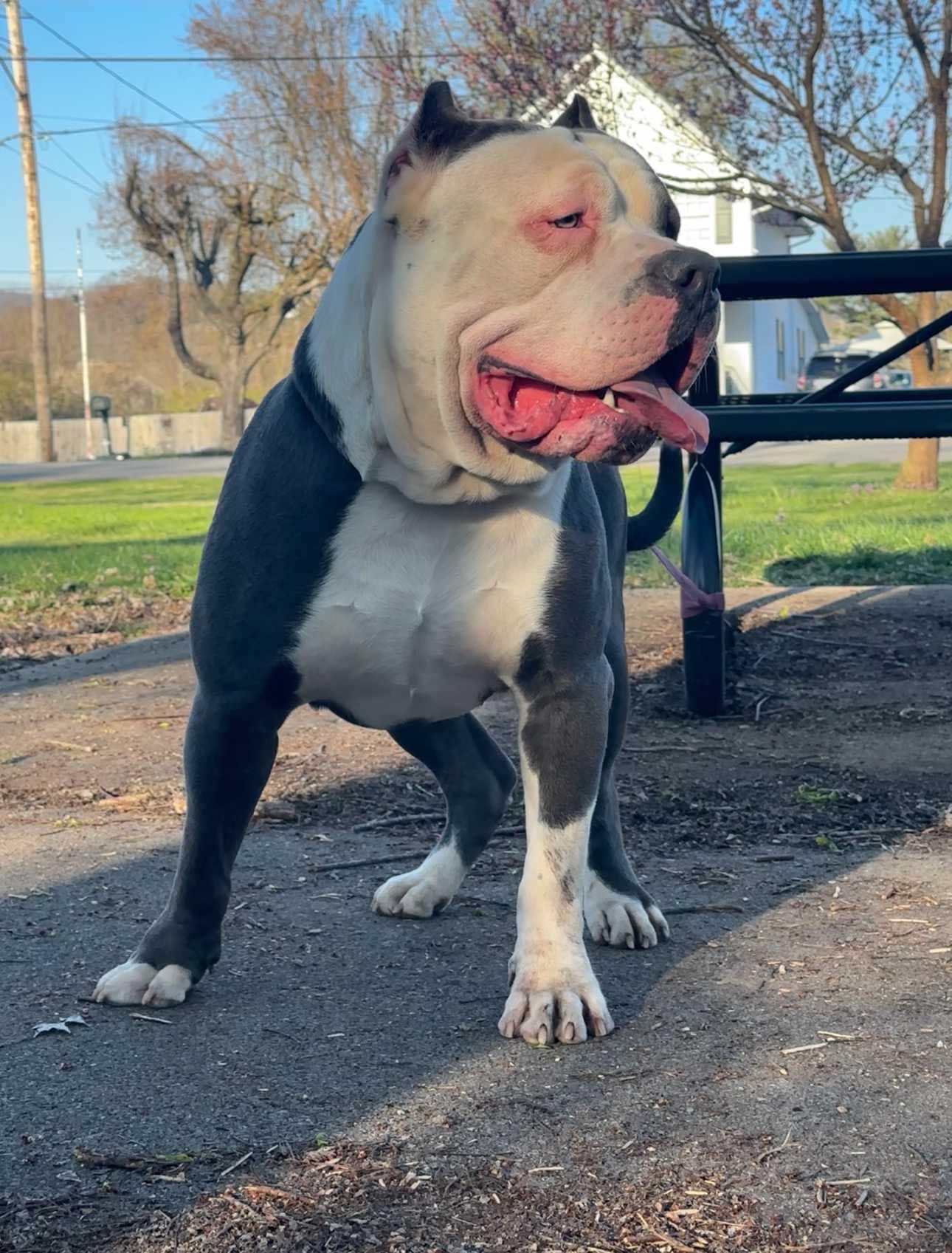
- Classic Bully: The Classic American Bully is similar in size to the Standard, but with lighter body frames. They retain the muscle tone and physical traits but are less bulky. This size aims to reflect the traditional American Pit Bull Terrier and American Staffordshire Terrier traits.
- It has a lighter body frame and less overall body mass but is still muscular.
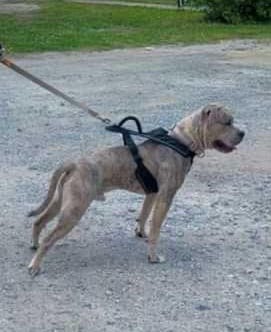
- Exotic Bully: The Exotic Bully is a more recent variation, known for its exaggerated features and unique appearance. They come in two classes: Micro Exotics (13 inches or smaller) and Extreme Exotics (larger than 13 inches but with more exaggerated features). Exotic Bullies often have a more compact and stocky build with a pronounced stop, wider skull, and shorter muzzle. They are bred for a distinct look, which sets them apart from the standard American Bully sizes.
- This is the smallest size of the American Bully.
- It is compact and packed with muscle.
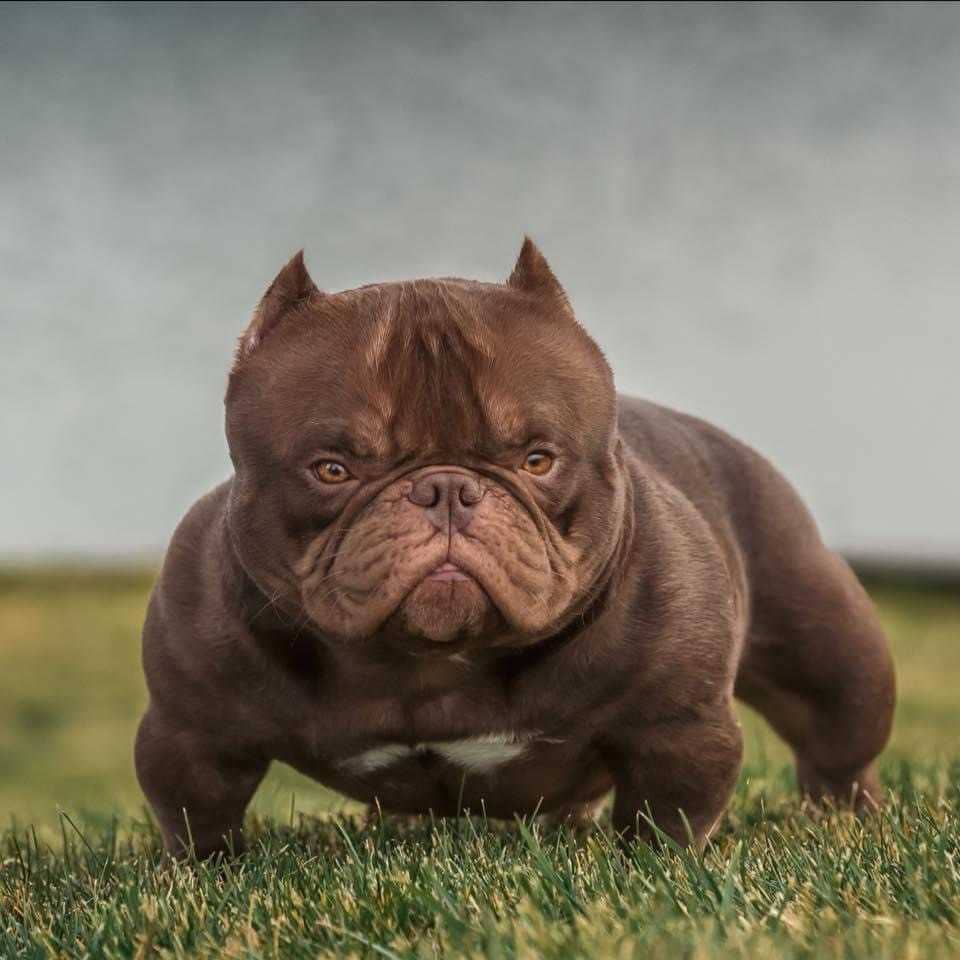
Each size has its own unique characteristics, but all American Bullies are known for their loyalty, affection, and physical strength. They are great family pets and are especially good with children.
American Bully Colors
The American Bully breed exhibits a wide range of colors. Here are some of the different colors found in the breed:
- Fawn: A light tan or yellowish color.
- Blue: This can range from a deep navy or slate gray to a lighter grayish-blue.
- Black: A solid, jet black color.
- Chocolate: A rich, deep brown.
- Tri-color: This refers to dogs that have three distinct colors, often black, white, and tan or brown.
- Brindle: A pattern of dark stripes on a lighter background, which can come in various color combinations.
- White: A solid white or predominantly white with patches of other colors.
- Merle: A mottled pattern of dark patches against a lighter background.
- Lilac: Also called Isabella, it’s a diluted chocolate color, often with a hint of purple or blue.
- Champagne: A diluted fawn color, often with a pinkish or light tan hue.
It’s important to note that while color can be an interesting aspect of a dog’s appearance, it doesn’t determine the dog’s temperament, health, or suitability as a pet. When choosing a dog, it’s essential to consider more than just its color.
American Bully Grooming
The American Bully boasts a short, smooth coat that lies very close to their skin. Regular brushing is essential to maintain the coat’s health, as it not only helps remove loose hairs but also evenly distributes the skin’s natural oils. While these dogs don’t require frequent baths, it’s essential to clean them up if they get into something messy. Overbathing can lead to stripping away the natural oils from their skin, which can result in dryness and irritation. Due to the nature of their short coat, American Bullies can sometimes be prone to skin issues. It’s crucial to inspect their skin regularly for any signs of rashes, sores, or potential allergies.
When it comes to shedding, the American Bully does lose hair, but it’s typically on the minimal side. The hairs they shed, being short, tend to be less conspicuous on furniture and clothing compared to the hairs of longer-coated breeds. However, it’s worth noting that their shedding might increase seasonally, especially during the transitional periods of spring and fall. During these peak shedding times, brushing them more frequently can help manage and reduce the loose hair. A balanced diet and overall good health can also play a role in minimizing excessive shedding.
Beyond their coat, considering the American Bully’s muscular build and active disposition, it’s also vital to pay attention to their paws, nails, and ears. Regular nail trims and ear cleanings can go a long way in preventing potential health complications. And, as always, when grooming an American Bully, it’s recommended to use dog-specific shampoos and products to ensure they are both safe and suitable for the dog’s skin type. In essence, while the American Bully does have some grooming needs, they are relatively easy to care for, and with regular attention, they can always be kept looking their best.
Common Bully Health Issues
Like all breeds, the American Bully can be susceptible to certain health issues. Here are some common health problems associated with the breed:
- Hip Dysplasia: This is a genetic condition where the hip joint doesn’t develop properly, leading to arthritis and pain. It’s common in many larger breeds and can be diagnosed through X-rays.
- Demodectic Mange: Caused by the Demodex mite, this skin condition can lead to hair loss, redness, scaling, and secondary bacterial infections. While all dogs have these mites, some American Bullies may have an immune system that doesn’t keep them in check, leading to an overgrowth.
- Allergies: American Bullies can be prone to both food and environmental allergies. Symptoms can include itching, redness, and ear infections. Identifying and eliminating the allergen is crucial for treatment.
- Heart Disease: Like many breeds, the American Bully can be susceptible to various heart conditions. Regular check-ups and early detection are vital.
- Cleft Palate or Cleft Lip: This is a congenital condition where there’s a split or opening in the mouth’s roof or lip. It can affect the dog’s ability to eat and may require surgical correction.
- Luxating Patella: This condition occurs when the kneecap moves out of its natural position. It can cause pain and lameness and may require surgery.
- Ichthyosis: A skin condition where the dog produces too many skin cells, leading to flaky, dry skin.
- Ear Infections: Due to their ear shape, American Bullies can be prone to ear infections. Regular cleaning and check-ups can help prevent this issue.
- Thyroid Issues: Hypothyroidism, where the thyroid doesn’t produce enough hormones, can be a concern for the breed. Symptoms can include weight gain, lethargy, and skin problems.
- Elbow Dysplasia: Similar to hip dysplasia, this is a developmental defect of the elbow joint, leading to pain and arthritis.
It’s essential for American Bully owners to be aware of these potential health issues and to seek regular veterinary care to ensure their pet’s well-being. Early detection and treatment can make a significant difference in the dog’s quality of life.
Conclusion
The American Bully stands as a testament to the power of selective breeding in achieving a distinct and admirable canine companion. With its robust physique juxtaposed against a gentle and affable temperament, this breed defies initial perceptions, proving to be a loving family member rather than just a formidable presence. Its origins, deeply rooted in the late 20th century, showcase a blend of various breeds, each contributing to the Bully’s unique characteristics. While they may face certain health challenges, with responsible breeding and care, the American Bully can lead a fulfilling life. Above all, the breed embodies loyalty, resilience, and an unwavering bond with its human counterparts, making it a cherished addition to households worldwide.


